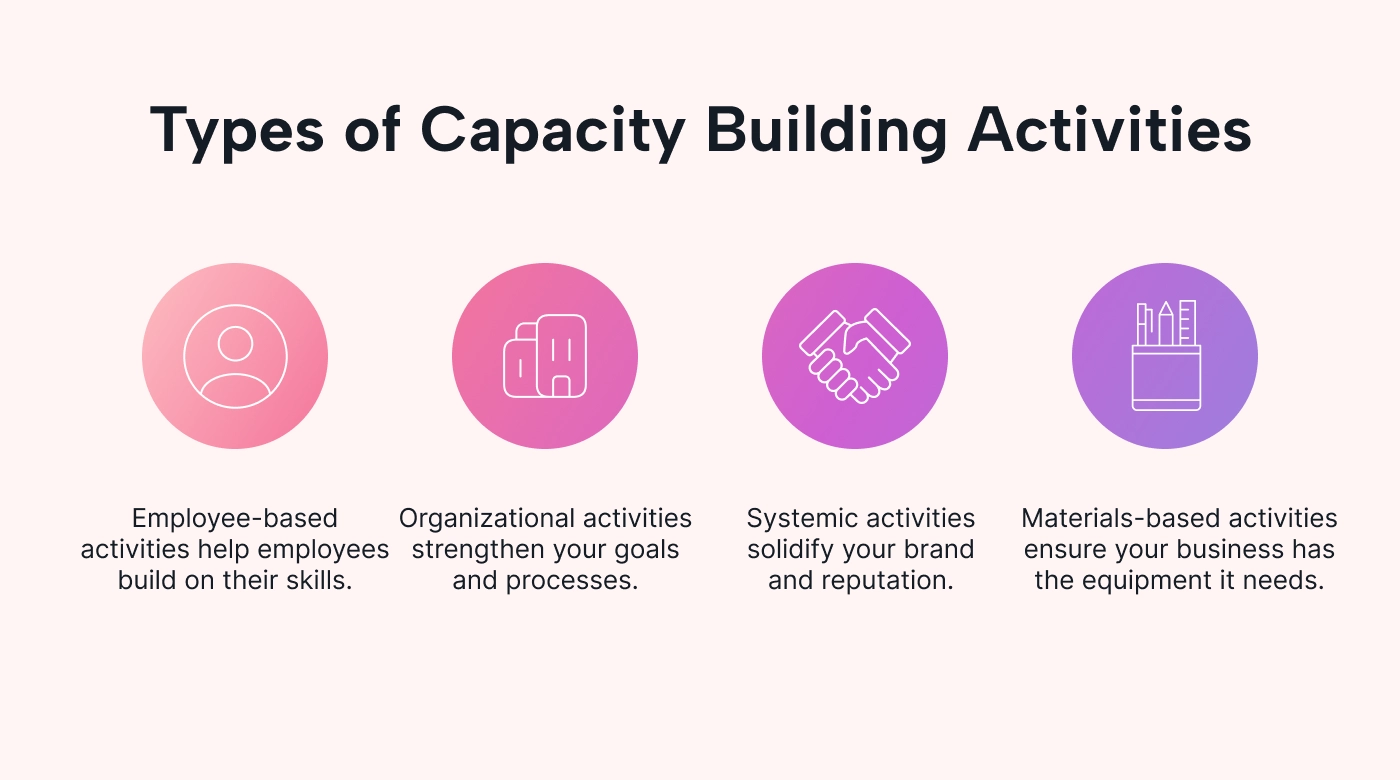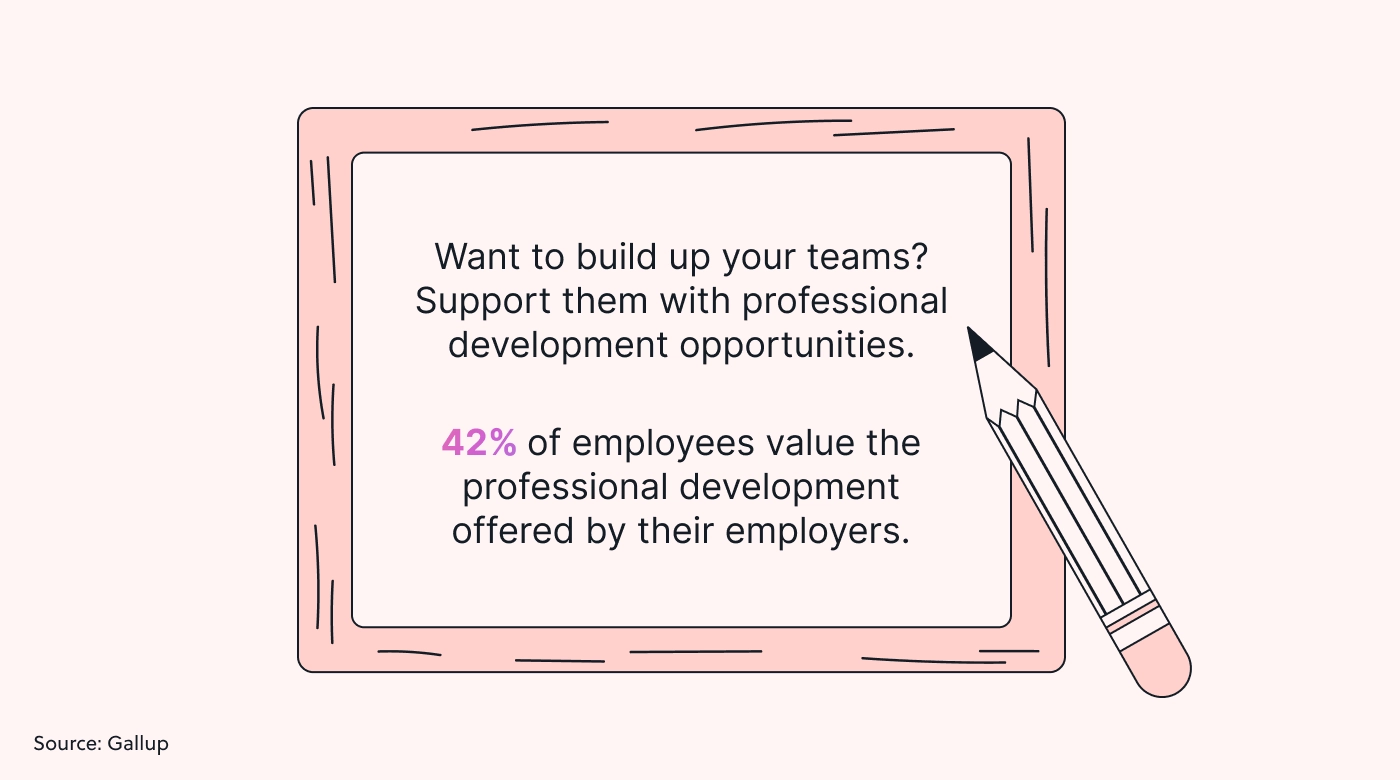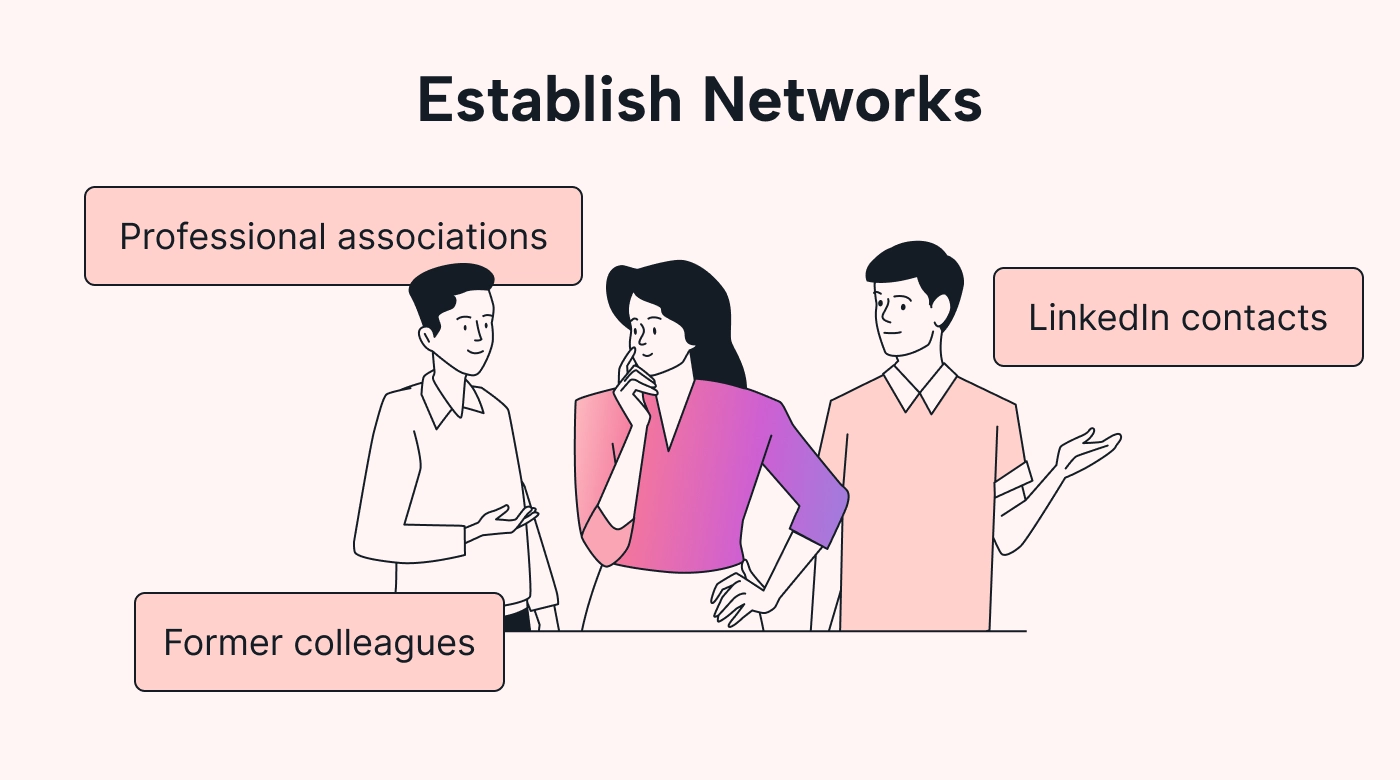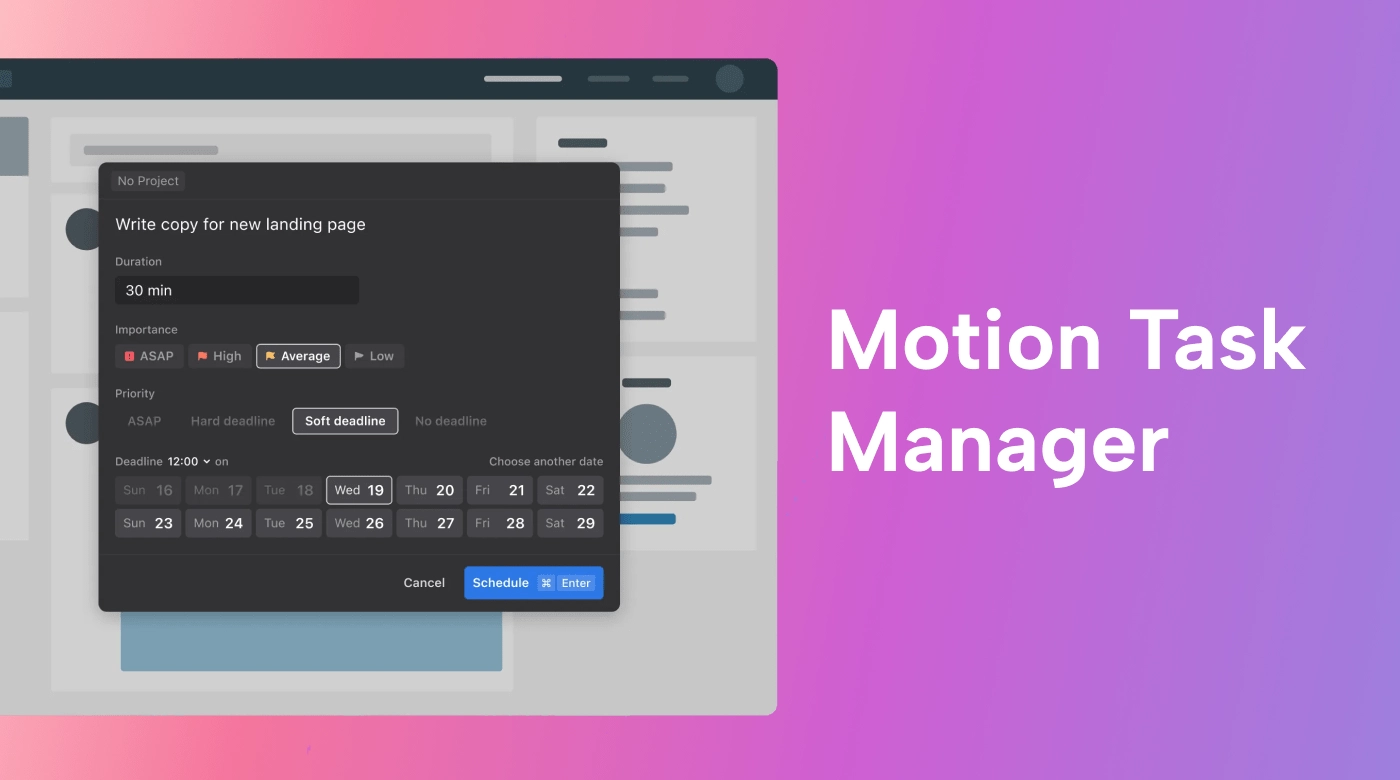Even if your organization has a solid mission statement, you may wonder if it’s actually delivering on its promises.
Knowing what you want to do and why you want to do it is only part of the process. Building capacity (and strengthening your business processes as a result) is how you’ll achieve your goals and maintain success.
This article explains the basics of capacity building, including its importance and the main types to consider. We also share capacity-building activities that your business can use right away.
What is capacity building?
Capacity building refers to the processes and approaches that businesses use to fulfill their mission and achieve their goals.
Organizations build capacity by implementing strategies to improve their employees’ knowledge, skills, and abilities. These strategies can range from offering professional training opportunities to ensuring employees have access to the right materials.
Capacity building also includes the steps taken to strengthen an organization and expand its presence in the community.
In essence, capacity building is essential for any organization that wants to go from good to great.
It’s also important to know how capacity building differs from capacity planning. Let’s take a look.
How do capacity building and capacity planning differ?
In short, capacity building is active. It’s the steps, processes, and actions your business takes to improve its teams and meet its goals.
Capacity planning, on the other hand, is passive. It’s also closely aligned with project management. With capacity planning, you assess your team’s needs and ensure you have the proper staffing, resources, and timelines to complete your tasks.
Now that you know the basics of capacity building, let’s examine why it’s such a critical component of a business’s success.
What is the importance of capacity building?
Building strong capacity in your business, teams, and employees offers many benefits:
- It clarifies the organization’s mission, vision, and values for you, your employees, and the company stakeholders. This allows you to identify the actionable steps needed to achieve your goals.
It can also lead to greater success. In fact, finance companies that share their explicit mission statements on their websites show higher return on assets (ROA) than those that don’t.
- Businesses that focus on capacity building capitalize on their strengths.

Knowing where your business shines informs your processes moving forward. For example, you may have a strong company culture that prioritizes diversity and inclusion. Evaluate — and, if necessary, revamp — your recruitment and hiring efforts to ensure you can continue to find top talent.
- Capacity building addresses weaknesses, allowing you to target areas in your organization that need improvement.
Let’s say you determine your employees are leaving due to a lack of upskilling opportunities. You can address this directly by providing the training and professional development they’re looking for.
- Capacity building increases engagement and collaboration among team members. Employees who feel connected with the company tend to offer ideas, share concerns, and address issues proactively. They then become more engaged, and team relationships strengthen as a result.
Top-performing organizations boast 70% employee engagement rates, as they focus on capacity building around a solid workplace culture.
- Targeted capacity building improves productivity and profitability. As a result, employees with the knowledge, skills, and resources needed to get tasks done are more efficient and productive.
Businesses with a clear mission develop clear, actionable objectives to meet their goals, saving time, energy, and money in the long run.
- Capacity building strengthens employee development. You can identify where employees need training and adjust accordingly. You can also pinpoint areas for upskilling or find suitable candidates for advancement.
- Robust capacity building improves or maintains long-term customer satisfaction and retention. Efficient, collaborative teams deliver quality projects on time.
Skilled employees successfully resolve customer complaints and address issues, leading to higher loyalty rates.
If you’re ready to enjoy the benefits of capacity building, Let’s get into a brief rundown of the different types.
What are the different types of capacity building?
Think of capacity building through four primary activities.

Employee-based capacity building
Employee-based capacity building zeroes in on individual needs, which is critical for providing employees with the necessary skills and resources to do their jobs well. It’s also important for enhancing employee well-being and retaining top talent.
Examples of employee-based capacity building include providing professional development, training, and upskilling programs.
Organizational capacity building
Organizational capacity building addresses the big picture, leading to more focused long-term goals and objectives.
For example, HR could obtain consistent employee feedback about culture and climate by regularly sending out pulse surveys.
Systemic capacity building
Systemic capacity building centers on the community by bolstering the brand and business’s reputation. One way to achieve this is by developing a mutually beneficial partnership with a business in an adjacent industry.
Materials-based capacity building
Materials-based capacity building strengthens the business’s physical components to ensure employees have the appropriate materials to meet their goals. This may include investing in automated services that help HR streamline employee onboarding.
Top capacity building activities
With these four types of capacity building in mind, your business has a wide range of options to start with. Narrow it down to your top business needs and go from there.
You may need to gather feedback from each of your business’s departments to decide whether to focus on one type or start building capacity in several types.
1. Streamline your onboarding process
Analyze how your business approaches onboarding and focus on the essential pieces to get your newest employees up and running as soon as possible.
Connect new hires with a peer in their department. Introduce them to their fellow team members early on so they can learn the ropes and establish connections. Also, provide them online access to any required but tedious forms, such as emergency contacts and W2s, so that they can complete them during their downtime.
2. Improve employee training programs
Continue focusing on your employees by investing in robust training and professional development programs.

Connect the webinars, seminars, and workshops directly to their desired career paths.
Include upskilling opportunities to keep top talent engaged and invested in your organization. If your real estate firm is expanding into new markets, for instance, train your agents on how to become luxury home specialists.
These opportunities are in high demand, with 42% of employees believing their organizations offer them their most important professional development opportunities.
3. Close skills gaps with professional certifications
Expand employee training opportunities to provide interested parties with access to professional certification achievement so they can continue to level up in their respective fields.
Access community resources to close the skills gaps or bring the workshops on-site or virtual, depending on the employee or team’s needs.
Connect certifications to business goals and long-term growth needs. For example, support new project managers with Project Management Professional (PMP) certification.
4. Connect employees to mentors
Employees starting in their respective fields might also benefit from a mentorship. If you want to stay on-site, pair a junior member with a senior within the department.
To expand your reach, invest in online membership programs where employees can access their choice of individuals. MentorCruise is an option for tech, design, and business workers.
5. Level up your leadership activities
Identify your future leaders and offer them job shadowing opportunities or apprenticeships in-house. Also, strengthen their soft skills and team relationships through various leadership activities. Have them kick off a monthly meeting or establish a series of leadership meet-ups for those interested in going the extra mile.
Try the “trust battery” exercise to positively impact relationships. Or have your team attempt the popular “marshmallow challenge,” which requires delegation and the ability to see the big picture.
6. Strengthen team collaboration
Boosting your teams supports your organization as a whole. As member relationships improve, you see the benefits of building stronger teams.
Consistent, positive collaboration helps employees develop empathy for their colleagues, leading to more efficient communication and problem-solving.
Clarify team roles and responsibilities, and identify and address gaps early on to create clarity and avoid confusion. Offer training for improving communication skills, such as role-playing situations that require conflict resolution.
7. Expand and deepen your industry networks
Step outside your organization and start to address your networks. Do you have solid relationships with like and adjacent businesses? Who can you go to to share information and problem-solve?

Create partnerships and form connections with professional associations, LinkedIn, or other social media platforms. Contact former colleagues, mentors, and supervisors and hold regular, informal coffee chats to stay connected and informed.
8. Send your teams to industry conferences
Conferences are an excellent way for teams and organizations to identify the latest trends and discuss how to apply them. They also provide another way to establish and strengthen in-person connections with industries.
In addition to improving your organizational systems, you’re also encouraging team building and personal connections off-site when you send your teams to conferences.
9. Prioritize diversity and inclusion practices
Look at your recruitment and hiring practices and long-term employee retention to see where you can make adjustments. Provide employee training focused on diversity, equity, and inclusion and what these things mean to the workplace.
Establish safe spaces where employees feel secure to open up opportunities for discussion. These practices matter to your workers. Employees who feel valued by their organizations are 57% less likely to experience burnout.
10. Implement well-being initiatives
A positive sense of well-being also decreases the likelihood of burnout. Only 24% of employees feel their employer cares about their well-being, so organizations have some work to do.
Support a better work-life balance by offering flexible working hours. Encourage employees to establish and maintain clear boundaries between home and work by taking lunch breaks and available PTO. Consider providing mental health days or access to wellness app subscriptions (e.g., Calm or Headspace).
11. Upgrade employee materials and workspaces
If you purchase new equipment before it’s needed, your employees and organization will thank you. Nothing slows productivity faster than inefficient or outdated technology.
If your employees are on site, ensure that they have access to break spaces, meeting rooms, informal collaborative areas, and personal workstations. Implement different workstation options, too, such as standing desks or balance ball chairs. Plus, invest in robust security systems to increase employee safety and protect your physical equipment.
12. Use automation to save time
Investing in automation reduces the time spent on manual, repetitive, or tedious tasks.
For example, AI can support email organization. Hiver works with Google Workspaces to help employees assign, track, and collaborate on emails within shared inboxes.
You can also use AI to craft the perfect schedule.

The Motion Task Manager cuts down on planning and scheduling time. Add your task based on its priority, and Motion will slot it into the perfect spot on your calendar. And if an emergency meeting arises, Motion will automatically reorganize your tasks so you won’t miss a beat.
13. Increase meeting efficiency
Your organizational systems benefit when you analyze meeting quantity and quality to eliminate redundancies and unnecessary conferences.
Focus on techniques to master meetings effectively by enlisting an AI meeting assistant. Ramp up meeting efficiency by sending out agendas beforehand and assigning members key roles, such as note-taker or time-keeper.
14. Expand community outreach efforts
Are you having the impact you want on your community? If not, focus on identifying and building your brand and getting the word out through targeted marketing efforts.
Raise public awareness of your business and showcase your involvement in the community. Host a booth at the county fair or local farmer’s market and give out branded pens, totes, or other items when potential customers stop by.
15. Get involved
Addressing your business's social responsibility is another key to building your brand and community outreach.
Join advocacy groups or local campaigns targeting causes of interest. For example, join a local environmental group focused on sustainable practices.
Participate in the local causes you care about, too. For example, a construction or real estate business could volunteer their time or donate materials to Habitat for Humanity.
Take capacity building to the next level with Motion
Capacity building is essential for businesses looking to improve their processes, strengthen their systems, and deliver results.
So, why not optimize your capacity-building initiatives even further with Motion?
Motion streamlines workflows by removing the tedious aspects of schedule planning to craft the perfect schedule. It takes your tasks and to-dos and slots them around your meetings and other events based on your priorities and availability. And if something unexpected crops up (as it inevitably will), Motion does the heavy lifting and rearranges your tasks accordingly.
Don’t wait to start capacity building. Contact Motion to start your risk-free trial today.
Try Motion for free for 7 days here

Jodi Monroe is a content writer and blogger in the SaaS space. When not at her laptop, she’s planning her next travel adventure.




